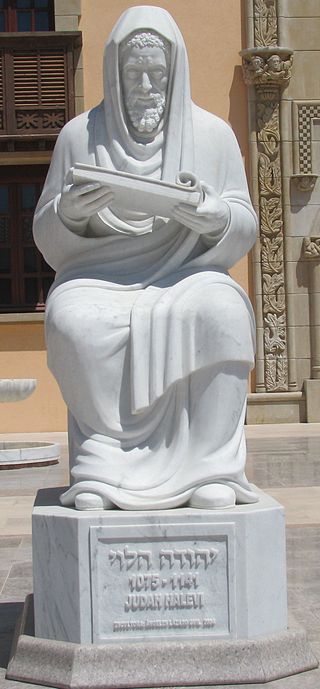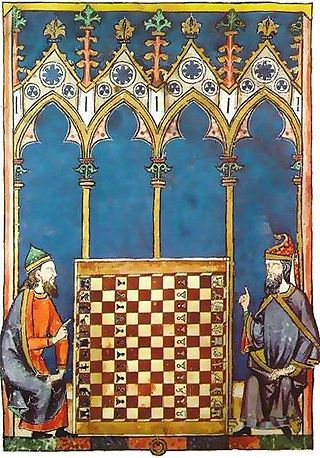Related Research Articles

SephardicJews, also known as Sephardi Jews or Sephardim, and rarely as Iberian Peninsular Jews, are a Jewish diaspora population associated with the Iberian Peninsula. The term, which is derived from the Hebrew Sepharad, can also refer to the Jews of the Middle East and North Africa, who were also heavily influenced by Sephardic law and customs. Many Iberian Jewish exiled families also later sought refuge in those Jewish communities, resulting in ethnic and cultural integration with those communities over the span of many centuries.

Judah Halevi was a Spanish Jewish poet, physician and philosopher. He was born in Spain, either in Toledo or Tudela, in 1075. He is thought to have died in 1141, in either Jerusalem, at that point the Crusader Kingdom of Jerusalem, or in Alexandria, Egypt.

The Kuzari, full title Book of Refutation and Proof on Behalf of the Despised Religion, also known as the Book of the Khazar, is one of the most famous works of the medieval Spanish Jewish philosopher, physician, and poet Judah Halevi, completed in the Hebrew year 4900 (1139-40CE).
The golden age of Jewish culture in Spain, which coincided with the Middle Ages in Europe, was a period of Muslim rule during which, intermittently, Jews were generally accepted in society and Jewish religious, cultural, and economic life flourished.

Moroccan Jews constitute an ancient community. Before the founding of the State of Israel in 1948, there were about 265,000 Jews in the country, which gave Morocco the largest Jewish community in the Muslim world, but by 2017 only 2,000 or so remain. Jews in Morocco, originally speakers of Berber languages, Judeo-Moroccan Arabic or Judaeo-Spanish, were the first in the country to adopt the French language in the mid-19th century, and unlike the Muslim population French remains the main language of members of the Jewish community there.

The history of the Jews in the current-day Spanish territory stretches back to Biblical times according to Jewish tradition, but the settlement of organised Jewish communities in the Iberian Peninsula possibly traces back to the times after the destruction of the Second Temple in 70 CE. The earliest archaeological evidence of Hebrew presence in Iberia consists of a 2nd-century gravestone found in Mérida. From the late 6th century onward, following the Visigothic monarchs' conversion from Arianism to the Nicene Creed, conditions for Jews in Iberia considerably worsened.

Leon de Modena or in Hebrew name Yehudah Aryeh Mi-Modena (1571–1648) was a Jewish scholar born in Venice to a family whose ancestors migrated to Italy after an expulsion of Jews from France.
Nicholas Donin of La Rochelle, a Jewish convert to Christianity in early thirteenth-century Paris, is known for his role in the 1240 Disputation of Paris, which resulted in a decree for the public burning of all available manuscripts of the Talmud. Latin sources referred to him as "Repellus," referring to his native La Rochelle.
David Alroy or Alrui, also known as Ibn ar-Ruhi and David El-David, was a Jewish Messiah claimant born in Amadiya, Iraq under the name Menaḥem ben Solomon. David Alroy studied Torah and Talmud under Hasdai the Exilarch, and Ali, the head of the Academy in Baghdad. He was also well-versed in Muslim literature and known as a worker of magic.
Solomon ibn Verga or Salomón ben Verga was a Spanish historian, physician, and author of the Shevet Yehudah.
Moses Amon also known as Moses Hamon (Amon) was the son of Joseph Hamon, born in Spain. Going with his father to Constantinople, he became physician to Suleiman the Magnificent. This "famous prince and great physician," as he is called by Judah ibn Verga, accompanied the monarch on all his expeditions, enjoying great favor on account of his knowledge and skill.
Judah ibn Verga was a Spanish historian, kabalist, perhaps also mathematician, and astronomer, of the 15th century, born at Seville. He is supposed to have been the grandfather of Solomon ibn Verga, author of the Shebeṭ Yehudah, and it is this work which furnishes some details of Ibn Verga's life.
Joseph ibn Verga was a Turkish rabbi and historian who lived at Adrianople at the beginning of the 16th century.
The 1066 Granada massacre took place on 30 December 1066 when a Muslim mob stormed the royal palace in Granada, in the Taifa of Granada, killed and crucified the Jewish vizier Joseph ibn Naghrela, and massacred much of the Jewish population of the city.
Don Vidal Benveniste de la Cavalleria was a Spanish Jew who lived in Saragossa Spain, during the second half of the 14th and beginning of the 15th century. He was elected, by the notables of the Jewish communities of Aragon, as the speaker before the pope at the beginning of disputation of Tortosa (1413), because of his knowledge of Latin and his reputed wisdom.

Samuel Usque was a Portuguese converso Jewish author who settled in Ferrara. Usque was a trader.
North African Sephardim are a distinct sub-group of Sephardi Jews, who descend from exiled Iberian Jewish families of the late 15th century and North African Maghrebi Jewish communities.

Modern Jewish historiography is the scholarly analysis of Jewish history into the modern era. While Jewish oral history and the collection of commentaries in the Midrash and Talmud are ancient, with the rise of the printing press and movable type in the early modern period, Jewish histories and early editions of the Torah/Tanakh were published which dealt with the history of the Jewish religion, and increasingly, national histories of the Jews, Jewish peoplehood and identity. This was a move from a manuscript or scribal culture to a printing culture. Jewish historians wrote accounts of their collective experiences, but also increasingly used history for political, cultural, and scientific or philosophical exploration. Writers drew upon a corpus of culturally inherited text in seeking to construct a logical narrative to critique or advance the state of the art. Modern Jewish historiography intertwines with intellectual movements such as the European Renaissance and the Age of Enlightenment but drew upon earlier works in the Late Middle Ages and into diverse sources in antiquity.
References
- ↑ Hamilton, Michelle M.; Silleras-Fernandez, Nuria (2021-04-30). In and Of the Mediterranean: Medieval and Early Modern Iberian Studies. Vanderbilt University Press. ISBN 978-0-8265-0361-9.
- ↑ Funkenstein, Amos (1989). "Collective Memory and Historical Consciousness". History and Memory. 1 (1): 5–26. ISSN 0935-560X. JSTOR 25618571.
- ↑ Melton, J. Gordon (2014). Faiths Across Time: 5,000 Years of Religious History [4 Volumes]: 5,000 Years of Religious History. ABC-CLIO. p. 1514. ISBN 978-1-61069-026-3.
- ↑ Cohen, Jeremy (2017). A Historian in Exile: Solomon ibn Verga, "Shevet Yehudah," and the Jewish-Christian Encounter. University of Pennsylvania Press. ISBN 978-0-8122-4858-6. JSTOR j.ctv2t4c2k.
- ↑ "Ibn Verga, Solomon". www.jewishencyclopedia.com. Retrieved 2023-11-05.
- ↑ "The "Shebet Yehudah" and sixteenth century historiography | Article RAMBI990004793790705171 | The National Library of Israel". www.nli.org.il. Retrieved 2023-11-05.
- ↑ Raz-Krakotzkin, Amnon (2007). "Jewish Memory between Exile and History". The Jewish Quarterly Review. 97 (4): 530–543. ISSN 0021-6682. JSTOR 25470226.
- 1 2 Cohen, Jeremy (2013). "Interreligious Debate and Literary Creativity: Solomon ibn Verga on the Disputation of Tortosa". Jewish Studies Quarterly. 20 (2): 159–181. doi:10.1628/094457013X13661210446274. ISSN 0944-5706. JSTOR 24751814.
- 1 2 Cohen, Jeremy (2009), "The blood libel in Solomon ibn Verga's Shevet Yehudah", Jewish Blood, Routledge, pp. 128–147, doi:10.4324/9780203876404-13, ISBN 978-0-203-87640-4 , retrieved 2023-11-05
- ↑ Ruderman, Daṿid; Veltri, Giuseppe; Wolfenbütteler Arbeitskreis für Renaissanceforschung; Leopold-Zunz-Zentrum zur Erforschung des Europäischen Judentums; Herzog August Bibliothek, eds. (2004). Cultural intermediaries: Jewish intellectuals in early modern Italy. Jewish culture and contexts. Philadelphia, Pa: University of Pennsylvania Press. ISBN 978-0-8122-3779-5.
- ↑ Wacks, David A. (2015). Double Diaspora in Sephardic Literature: Jewish Cultural Production Before and After 1492. Indiana University Press. ISBN 978-0-253-01572-3. JSTOR j.ctt16gzfs2.
- ↑ Diner, Hasia R. (2021). The Oxford Handbook of the Jewish Diaspora. Oxford University Press. ISBN 978-0-19-024094-3.
- ↑ Schuartz, Miriam Sílvia (2011-10-05). "Presença do Sublime na Consolação às Tribulações de Israel, de Samuel Usque". Vértices: 140–158. doi: 10.11606/issn.2179-5894.ip140-158 . ISSN 2179-5894.
- ↑ Loeb, Isidore (1892). "Le folk-lore juif dans la chronique du Schébet Iehuda d'Ibn Verga". Revue des études juives. 24 (47): 1–29. doi:10.3406/rjuiv.1892.3805. S2CID 263176489.
- ↑ Rist, Rebecca (2015-12-17). "Papal Power and Protection in the Shebet Yehudah". Journal of Religious History. 40 (4): 490–507. doi: 10.1111/1467-9809.12324 . ISSN 0022-4227.
- ↑ Watts, James W. (March 2011). "Jewish Blood: Reality and Metaphor in History, Religion, and Culture". Religion. 41 (1): 105–107. doi:10.1080/0048721x.2011.553085. ISSN 0048-721X.
![]() This article incorporates text from a publication now in the public domain : Singer, Isidore; et al., eds. (1901–1906). "Solomon Ibn Verga". The Jewish Encyclopedia . New York: Funk & Wagnalls.
This article incorporates text from a publication now in the public domain : Singer, Isidore; et al., eds. (1901–1906). "Solomon Ibn Verga". The Jewish Encyclopedia . New York: Funk & Wagnalls.